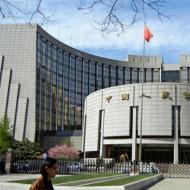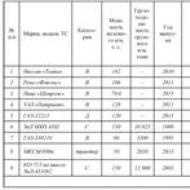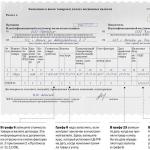
Russian banks in China. Central Bank of the Russian Federation in China: we have opened Features of the banking system
It is a common belief that all banks in China are state-owned. In fact, this is not true. Today, only three banks in China remain fully state-owned: Agricultural Development Bank of China, China Development Bank and Export-Import Bank of China. Most banks in the country are commercial and have joint stock ownership.
However, state control remains significant. This is primarily manifested in the activities of the People's Bank of China, the National Banking Regulatory Commission (CBRC) and the Ministry of Finance of the People's Republic of China. In addition, in the largest joint-stock banks the state owns a controlling stake.
One of the largest banks in China. It was founded in 1912 and is the oldest bank in the country. In 1949, after the founding of the People's Republic of China, the bank became an active participant in the international operations of the Chinese government. In 1994, Bank of China (BOC) received the status of a state-owned commercial bank. In 2006, the bank was transformed into a joint-stock company (LTD) - its shares appeared on the Hong Kong stock exchange.
Today the controlling stake belongs to the Chinese government.
In 1993, Bank of China opened a subsidiary bank in Russia - JSCB BANK OF CHINA (ELOS). Now there are several branches in the Russian Federation: the head office in Moscow, branches in Khabarovsk and Vladivostok. In 1993, a subsidiary, Bank of China in Kazakhstan, was also opened in Almaty.
This is the most international bank in China - it has about 550 representative offices in 27 countries.
Main activities:
- Corporate and consumer lending
- Investment
- Insurance
- Currency exchange
- Bank card service
- Total assets (2011): 11.83 trillion yuan
- Net profit (2011): 130.319 billion yuan (2010 net profit after tax was 109.691 billion)
- Number of employees (2011): 289,951
It is also one of the largest banks in the country. Agricultural Bank of China (ABC) was founded in 1951.
At the end of the 70s, the bank became commercial, but was still entirely state-owned. On January 15, 2009, it was transformed into a joint stock limited liability company.
Main activities:
- Investment
- Insurance
- Bank card service
- Total assets (2011): 11.67757 trillion yuan
- Net profit (2011): 121.956 billion yuan
One of the four largest banks in China. Was founded in 1954. In 2004, Construction Bank became a joint stock bank. In 2005, the bank conducted an IPO on the Hong Kong stock exchange. In 2005, Bank of America acquired a 9% stake in the bank for $3 billion.
Currently, Construction Bank is part of the International ATM Alliance, a joint venture of several international banks, which allows clients of these banks to use each other's ATMs around the world without commission.
By the end of 2011, there were 13,581 bank branches in mainland China. CCB branches in Hong Kong, Singapore, Frankfurt, Johannesburg, Tokyo, Seoul, New York, Ho Chi Minh City and Sydney, representative offices are located in Moscow and Taipei. The bank has several subsidiaries: CCB Asia, CCB Financial Leasing, CCB International, CCB Trust, Sino-German Bausparkasse, CCB London, CCB Principal Asset Management and CCB Life.
In its investment program, the bank pays great attention to the healthcare sector and related industries, including the production of medical equipment, pharmaceuticals, medical institutes and services.
Main activities:
- Corporate and retail lending
- Investment
- Insurance
- Total assets (2011): 12.282 trillion yuan
- Net profit (2011): 169.439 billion yuan
Western Union . Among them are Postal Savings Bank of China, Agricultural Bank of China, China Everbright Bank, Zhejiang Chouzhou Commercial Bank, Bank of Jilin, Harbin Bank, Fujian Haixia Bank, Yantai Bank, Longjiang Bank, Bank of Wenzhou, Huishang Bank, Shanghai Pudong Development Bank and China Construction Bank.
The Bank of Russia has completed creating conditions for placing Russian debt in yuan. This means that Russia will be able to raise money in Asia, thereby compensating for the lack of access to Western capital markets due to sanctions.
In Moscow, on March 22, a yuan settlement center will be opened at ICBC Bank, the founder of which is the largest Chinese commercial bank ICBC. He entered into a special agreement with the People's Bank of China, becoming its authorized bank in Russia.
Deputy Chairman of the Bank of Russia Dmitry Skobelkin and First Deputy Chairman of the People's Bank of China Yi Gan spoke about this at the opening in Beijing of the first foreign representative office of the Bank of Russia in modern history.
China is our main trading partner, and the opening of a clearing center will, on the one hand, spur the activity of Chinese business in Russia, on the other hand, it will become a channel for the entry of yuan liquidity into the country, which, in particular, will be used by Chinese investors to purchase federal loan bonds (OFZ) issued in Chinese currency.
Moscow's ICBC will become the first Chinese bank represented in the Russian Federation that will be able to take into account securities - its license will allow investors from Beijing to directly buy OFZs in yuan.
The Russian Ministry of Finance has been talking about plans for the debut “Chinese” bond issue in the equivalent of a billion dollars since 2015. The goal is to test the infrastructure and provide a benchmark for the cost of Russian risk in Asian markets. After this, Russian companies will also be able to issue bonds in yuan, attracting cheaper financing than in Russia.
The demand of Chinese investors for Russian securities is guaranteed. The last time the Ministry of Finance issued Eurobonds at 3.99 percent, while ruble federal loan bonds are trading at 8-8.5 percent. The yield on OFZs in yuan will lie somewhere in the middle, while now Chinese securities generate income at the level of 2.6-2.7 percent. The competitiveness of Russian bonds is obvious.
However, China is struggling with capital outflows, so Chinese investors need permission to buy securities abroad. The Chinese leadership has already stated that it supports the purchase of Russian bonds in principle, but has yet to agree on specific investment quotas.
In addition, as Dmitry Skobelkin told Rossiyskaya Gazeta, Russia and China are completing preparations for concluding a memorandum on exchange trading in gold. According to him, the People's Bank of China, which has the world's largest gold and foreign exchange reserves, has confirmed its interest in Russian supplies. Last year, our gold was certified at the Shanghai Exchange.
Now the parties are agreeing on the details of the memorandum, and in parallel, the mechanism for its implementation is being worked out, noted the Deputy Chairman of the Central Bank.
For China, the opened representative office of the Bank of Russia became the eighth one created by foreign central banks. The representative office should contribute to the development of cooperation between Russia and China in the financial sector, which has recently been rapidly gaining momentum. It will help increase payments in national currencies (now more than 80 percent of them are made in dollars), and protect the interests of Russian banks and non-credit organizations in the Chinese market.
There are already 8 representative offices of Russian banks and one branch operating in China, 64 Russian banks have correspondent accounts in Chinese banks.
"Mir" and UnionPay will begin issuing joint cards in April - June
By the time state employees and pensioners begin to be transferred to cards of the Mir payment system, Russian banks will have mastered the issuance of joint Mir-UnionPay cards.
The first such cards will appear in the second quarter of 2017, Alla Bakina, director of the National Payment System Department of the Bank of Russia, told Rossiyskaya Gazeta.
The problem of using Mir cards abroad has been solved through co-badging programs with international payment systems.
"Mir" - Maestro and "Mir" - JCB cards have already been issued, agreements have been signed on the issue of co-branding cards "Mir" - AmEx and "Mir" - UnionPay. In Russia they will work according to the rules of the Mir payment system, and abroad - according to the rules of international payment systems.
The user will be spared the need to carry two cards with him - international and national, having a card with one number and one PIN code, noted Alla Bakina.
The issue of Mir has exceeded three million, and plans are to issue more than 20 million national payment cards by the end of the year. “We provided favorable tariffs to banks so that they would be interested in developing a national payment card,” said Sergei Radchenkov, commercial director of NSPK, operator of the Mir payment system.
Igor ZUBKOV
You can view the infographic for the article.
At the moment, subsidiaries of four Chinese banks operate in Russia:
1. Joint-Stock Commercial Bank "Bank of China (Elos)" CJSC
Bank of China (“Elos”) was registered in 1993, one of the first subsidiary foreign banks in Russia. Its creator was the state-owned commercial Bank of China (BOC). The bank's 100% shareholder is the Chinese Bank of China. The main beneficial owner of the Chinese parent bank is the Chinese government (67.77%), the remaining shares are in free circulation and are held by minority shareholders.
In addition to the head office in Moscow, the bank has two branches (in Khabarovsk and Vladivostok). Corporate clients are offered settlement and cash services, lending, deposits (terms, interest rates are agreed on in each individual case), letters of credit, issuance of bank guarantees, factoring, forfaiting, collection and other services. The bank carries out settlements and money transfers in yuan. The main specialization of the bank is servicing trade turnover between the Russian Federation and China.
Since the beginning of 2014, the bank's net assets have increased 2.1 times. In liabilities, there is a significant influx of funds from foreign banks (in the form of loro balances), as well as funds in the current accounts of Russian corporate clients. In the active part of the balance sheet, almost all newly raised funds were placed in foreign banks, in the form of interbank loans and balances on nostro accounts (in total, more than 85% of net assets).
The bank's liabilities are 45% represented by borrowings from foreign banks (including large balances on loro accounts), another 39% are balances on current accounts of corporate clients (including non-resident companies), 11% are own funds (capital and reserves ), 8% - enterprise deposits. The share of individuals in the bank's liabilities is minimal (less than 1%).
The bank's client base is small, but actively growing. Payment activity is moderate, turnover on customer accounts amounts to 45 billion rubles monthly. Due to the specifics of the bank's client base, significant turnover is observed in the accounts of non-resident clients.
The bank's assets are 85% represented by placement of funds in banks (mainly foreign), 9% of assets are the loan portfolio. Funds in banks - 24.2 billion rubles. About 40% of the amount are loro balances in the parent bank, another 55% are short- and medium-term loans to foreign banks, a small deposit with the Central Bank.
At the end of 2013, the credit institution received a profit of 100.6 million rubles according to RAS, and for the nine months of 2014 - a profit of 71.3 million rubles.
2. CJSC "Joint-Stock Commercial Bank "Industrial and Commercial Bank of China" (Moscow)"
The credit institution was established in March 2013. It is a subsidiary of a large Chinese state-owned bank, China Construction Bank. Almost entirely financed by the parent company. The bank is included in the deposit insurance system. Fully controlled by the parent company China Construction Bank (100%).
The ultimate beneficiaries of the bank are the Ministry of Finance of the People's Republic of China (57.14%), the Ministry of Finance of Singapore (7.44%), the Government of the People's Republic of China and Hong Kong (4% combined), as well as private investors (31.4%). According to the bank, the organization's main activity is supporting Chinese businesses in Russia. Legal entities have access to various types of loans (overdraft, line of credit), bank guarantee, letters of credit, syndicated loans, cash settlement services, transaction support within the framework of trade and export financing, and transactions on the foreign exchange market. The bank practically does not work with individuals.
Since the beginning of 2014, the bank's net assets have increased to 11.9 billion rubles (1.9 times). In liabilities, there is a significant increase in funds of legal entities both in accounts (+2.4 billion rubles) and placed in deposits (+1.95 billion rubles). The volume of funds raised from other non-resident banks (loro balances) increased to 2.6 billion rubles (53.6%).
During the first half of 2014, the bank received a significant influx of client funds. In the active part of the balance sheet, the bank increased the volume of its loan portfolio to 3.5 billion rubles (28.6%) at the expense of the corporate portfolio. The volume of nostro balances in non-resident banks also increased significantly (+4.3 billion rubles).
The bank's liabilities are well diversified by sources of attraction. 20% are represented by balances on the accounts of legal entities, 16.3% - deposits of legal entities, 35.9% - own funds (capital and reserves), the remaining 27.5% are represented by funds raised from banks (loro balances). The client base is moderately active, turnover on client accounts amounts to 2-12 billion rubles monthly and is constantly growing in dynamics.
The bank's assets are 29.4% represented by the loan portfolio, 66.8% are funds placed in banks (nostro balances).
At the end of 2013, the credit institution received a profit of 60.9 million rubles according to RAS, and for the nine months of 2014 - a profit of 160 million rubles.
4. China Agricultural Bank LLC
Link to news
The credit organization was registered by the Bank of Russia on September 25, 2014.
China Agricultural Bank is a subsidiary of Agricultural Bank of China (ABC). The main beneficial owner of the Chinese parent bank is: 40.28% of its shares belong to the state investment company Central Huijin Investment, 39.21% - to the Ministry of Finance of the People's Republic of China, about 17% are traded on stock exchanges in Shanghai and Hong Kong. At the moment, the license of China Agricultural Bank LLC has not been received (the authorized capital has not been paid, but the legally established period for this has not yet expired).
Although the first three banks, like ABC, are in the top 10 of The Banker’s ranking in terms of Tier 1 capital, and ICBC is the largest bank in the world both in terms of capital and assets, their Russian divisions do not yet play a significant role in the market.
TPBC, according to Interfax, by the end of the second quarter of 2014, occupied 98th place among Russian banks in terms of assets (44.1 billion rubles), Bank of China (Elos) - 161st (21.8 billion rub.), China Construction Bank - 231st (11.9 billion rubles).
In the spring, against the backdrop of the introduction of the first sanctions and statements by Russian officials about the reorientation of the Russian economy towards Asia, banks with Chinese capital saw a sharp increase: TPBC assets grew by almost 80% from April to May, Bank of China (Elos) and China Construction Bank “The growth continued until August and was more than double. True, then it slowed down or stopped altogether.
The People's Republic of China is one of the world leaders in economic development, the pace of which continues to increase. It is no coincidence that the Chinese banking system in 2017 became the largest in the world in terms of assets: over the past year, the assets of Chinese banks exceeded the total volume of European banks by 2 trillion. US dollars. In addition, China owns the three largest banks in the world.
Features of the banking system
The number of banks in China is increasing every year. On the territory of the PRC there are state, commercial, joint-stock, city, private, credit, cooperative banks, as well as banking institutions in the special administrative regions of Macau and Hong Kong. The activities of all Chinese banks are regulated by the state.
When talking about how many banks there are in China, branches of foreign banking institutions and subsidiaries of financial institutions should also be taken into account. Today, there are about 800 banks in the People's Republic of China, which is an average of 0.6 banks per 1 million people.
In order to prevent financial, banking and currency crises, the Chinese banking system was reformed in 1997. As a result, over the past decades, China has managed to build a powerful banking system, as evidenced by the fact that three Chinese banks are among the largest financial institutions in the world.
Structure of the banking system
The Chinese banking system has a three-tier structure. The first level is formed by the People's Bank of China and three development banks. The People's Bank (central), being the issuing, credit and payment and settlement center of the country, is responsible for the development and implementation of monetary policy, and control and supervision of the banking system is carried out by the All-China Banking Regulatory Commission.
Three policy development banks—the State Development Bank of China, the Agricultural Development Bank of China, and the Export-Import Bank of China—are responsible for implementing government programs in the industrial, agricultural, and foreign trade fields, respectively.
The backbone of China's banking system is second-tier state-owned commercial banks, led by the Big Four banks, namely Bank of China, Industrial and Commercial Bank of China, Construction Bank of China and Agricultural Bank of China, which control about 60% of the Chinese market.
State commercial banks are both urban and rural in their scope of operation.
In addition, at the second level there are various financial companies that carry out banking operations: asset management corporations, trust investment companies, leasing financial companies.
The PRC also has a developed system of urban and rural cooperation, which is the basis for financing small and medium-sized businesses in the country and occupies the third level of the banking system. It exists in the forms of agricultural and urban credit cooperatives, as well as numerous post offices.
"Big Four"
The world's largest bank by total assets and most valuable by market capitalization in 2019 is the Industrial and Commercial Bank of China (ICBC). It ranks first in The Banker's Top 1000 World Banks ranking, as well as first in the Forbes Global 2000 list of the world's largest companies.
China Construction Bank (CCB) is another Chinese bank that is part of the Big Four and is headquartered in Beijing. In 2015, it became the second largest bank in the world by market capitalization. A subsidiary bank, CCB, is open in London, and its branches are in cities such as Barcelona, Johannesburg, Frankfurt, Luxembourg, New York, Tokyo, Singapore, Hong Kong.
ABC Bank (Agricultural Bank of China) is the third largest lender by assets. In 2015, it was ranked third on Forbes' annual list as one of the world's largest, most powerful and valuable companies. The bank's branches are located throughout the world: in Hong Kong, Japan, Great Britain, Germany, USA, Australia, South Korea and Singapore. 

Another powerful Chinese bank from the Big Four is Bank of China. It has the status of a state commercial company and is a joint stock company. Its representative offices are open in 27 countries, including Russia, where a subsidiary bank called Bank of China AKB Elos was founded. Its branches operate in Moscow, Vladivostok and Khabarovsk.
State and joint-stock banks
Only three banks have state status in China: the Export-Import Bank of China, the China Development Bank and the Agricultural Development Bank of China. These banks are directly responsible for foreign trade activities, industry and agriculture.
Commercial banks are divided into two main categories: state-owned and joint-stock. As noted above, state-owned commercial banks are among the so-called “Big Four”. And although these banks themselves are joint-stock companies, they are under state control, and their controlling stakes are held by the government.
China Construction Bank and Industrial and Commercial Bank of China were originally commercial. Bank of China Gao Yang (Bank of China) received the status of a state-owned commercial bank in 1994. The Agricultural Bank of China was originally state-owned, but became commercial in the late 70s.
In addition to the four banking institutions listed above, the government also includes the Postal Savings Bank of China, created in 2006 on the basis of the former Savings and Transfers Bureau. In terms of the size of deposits, this bank is in fifth place after the Big Four banks.
In the category of commercial banks, one of the most famous is the Bank of China ping an bank co ltd, whose headquarters are located in Shenzhen. This bank operates in Shanghai and Fuzhou. As a subsidiary of Ping An Insurance, the bank is one of the three structural components of Ping An Group, engaging in insurance, banking and asset management.
China Merchants Bank is also a successful commercial bank. Its headquarters are also located in southern China in Shenzhen. The bank became the first corporate-owned financial institution in China. CMB has more than 500 branches in mainland China and one in Hong Kong.
Another commercial bank owned by non-state entities is Minsheng Bank. This bank is known for providing loans to medium and small businesses. Today the bank has about 200 branches throughout mainland China.
Basic banking services
Speaking about what functions and operations of the central bank of China are the main ones, the following should be noted:
- implementation of monetary policy;
- issue of money supply and control of its circulation;
- administering the activities of financial institutions in accordance with existing regulations;
- exercising supervision and control over the financial market;
- management of state foreign exchange reserves and gold reserves;
- formation of the main interest rate;
- establishing rates for contributions to the reserve fund from money received from credit institutions;
- rediscounting of bills for credit institutions that are clients of the central bank;
- providing credit loans to private commercial banks;
- trading currencies and government bonds on the stock market.
All commercial banks in China (including the Big Four state-owned commercial banks) provide the following banking services:
- providing loans and attracting deposits;
- performing payments and servicing customers through cash registers;
- financing of investments by order of investors for the funds of depositors, as well as for the funds of the bank;
- issue, storage and sale of securities;
- provision of sureties and guarantees to third parties for financial transactions;
- sale and purchase of foreign currencies;
- sale and purchase of expensive stones and metals, as well as jewelry;
- the use of expensive metals as deposits;
- attraction and management of financial assets and securities on behalf of clients (trust operations);
- carrying out leasing operations, providing consultations, as well as brokerage services;
- opening bank accounts.
Opening an account
Foreigners can easily obtain a bank card in China. There are several options for opening an account in a Chinese bank for foreign citizens:
- Opening an account in foreign currency to receive wages. Foreign workers in China are allowed to receive wages in any currency; this requires an employment contract that specifies a clause on payment of wages in foreign currency.
- Opening an account to receive wages in Chinese yuan. In order to subsequently exchange the Chinese yuan for the currency you need, you must provide the bank with a work contract, a work permit in China, as well as proof of tax payment indicating the amount of salary.
- Opening an offshore account for a foreign company. This account can be opened in US dollars, Hong Kong dollars or euros. However, it should be borne in mind that when it comes to opening offshore accounts, banks can act at their own discretion, so opening an account largely depends on the choice of financial institution.
- Opening an account for a non-resident company in Chinese yuan. The procedure for opening an account for a foreign company that is not a resident of the PRC takes slightly longer than opening an offshore account, since it requires an agreement with the People's Bank of China.
Required documents
To open an account in a Chinese bank, an individual only needs to have a Chinese phone number and 20 yuan to pay for the card. The bank provides several forms to fill out in the form of a questionnaire, in which you should indicate your passport number, name, phone number and what you do in China (work, ). After signing the forms, bank employees issue a passbook, which is designed to display all completed financial transactions, or a debit bank card (depending on your request).
As for a credit card, it will be quite difficult for a foreigner to get one. To do this, the applicant must have a guarantor who has Chinese citizenship. In addition, many banking organizations set an amount of 3-5 thousand US dollars as a “non-burnable balance”.
Legal entities may be subject to additional requirements when opening bank accounts - this depends on the rules of individual banks. Basically, before opening an account, foreign companies must establish a subsidiary in China. In this case, the account registration process is relatively quick and simple. If you do not have confirmation of ownership of a subsidiary in China, then the list of required documents will be somewhat larger than usual, and the process itself will be longer and more complex.
International money transfer
There are several methods you can use to transfer money between China and other countries:
- bank transfer;
- international systems Western Union, MoneyGram, Contact, Unistream;
- Chinese payment system Union Pay;
- electronic money (Webmoney, Qiwi or other electronic wallets).
How to get a loan
All foreign individuals and legal entities have the right to apply for a loan from Chinese banks. However, in practice, it is quite difficult to get an affirmative answer from a Chinese financial institution. Chinese banks are afraid to issue loans, since if problems arise, they will have to be resolved through the court of the country of which the borrower is a citizen. Therefore, before contacting a bank for a loan, you must carefully review the required documents and provide certain guarantees (collateral). In particular, the loan volume must be at least $10 million, and at least 60% of this money must be used to pay for services and purchase goods in China.
How to get a mortgage
To obtain a mortgage loan from a Chinese bank, you must meet two basic requirements:
- work in China for more than one year on a work visa (it is preferable to purchase real estate in the city in which you work);
- have a guarantor in the person of a Chinese citizen (such guarantors are usually employers).
If these requirements are met, you can begin collecting the necessary documents. You will need:
- passport;
- resident card;
- any document confirming solvency (certified by the Chinese Embassy in your home country);
- a certificate from the place of employment indicating the amount of wages;
- confirmation of tax payment for the last year;
- work contract;
- marriage document or certificate confirming that the applicant is not married (translated into Chinese);
- a photocopy of the license of the organization providing the workplace.
Offshore accounts in Hong Kong
Hong Kong is a Special Administrative Region of China that does not impose income tax on businesses operated outside the region. Therefore, owners of companies located in mainland China often open accounts in Hong Kong. You can open an offshore account in Hong Kong for a company located in mainland China if you are the owner of a company that has existed for more than one year and has a capital of at least 10 thousand US dollars. Additionally, you must provide a certificate confirming full payment of all debts and necessary fees (Certificate of Good Standing), as well as a letter from the bank whose client the company is, confirming its solvency.
Foreign representative offices and branches
In 1985, Chinese banking legislation allowed foreign banks to open their representative offices in this country. The emergence of foreign banks in China was due to the rapid development of international trade and the creation of foreign enterprises in China. In 2007, the regulation on “Management of financial and credit institutions with foreign capital participation” was approved. This provision defines the range of banking operations, their number, as well as the minimum amount of assets for a foreign financial institution.
Foreign banks in China have the right to open their branch only after two years of existence of its representative office in the PRC if they have at least 20 billion US dollars in assets.
European banks in China
There are several branches of European banks operating in China, the most famous of which are the Dutch banks Algemene Bank Nederland and Amsterdam-Rotterdam Bank, the German bank Deutsche Bank and the Swiss bank Credit Suisse First Boston. In addition, French, Italian, Belgian and English banks also operate in China.
Russian banks in China
By 2019, of all the CIS countries, only Russia had opened several banking institutions in the Middle Kingdom. In particular, there are 8 representative offices and one branch of VTB Bank in China. Moreover, the VTB representative office in Beijing carries out operations only under export-import letters of credit. The bank's branch was opened in 2008 in Shanghai, and its purpose is to service trade turnover between China and Russia.
The representative office of Promsvyazbank was opened to serve the Russian companies Rostvertol and LOMO. Representative offices of other banks, including Sberbank, Gazprombank and the Central Bank of Russia, are also focused on a specific circle of Chinese clients, but operate in the PRC without the right to carry out banking operations.
China. The most interesting facts about China: Video
An entrepreneur just starting to work with China sometimes experiences stress from encountering Eastern business culture, which is very different from his native Russian and “familiar” European ones. That’s why it’s understandable to want to grasp at least some similar moments in your work; have something familiar at hand that you can rely on if necessary. One of these assistants is an indispensable participant in any business – banks.
Is it possible not to deal with Chinese banks (or reduce this interaction to a minimum), limiting ourselves to the services of only “our own”, domestic banks operating in the Middle Kingdom? Why not use the accounts of your dear Sberbank, if you can now find it in Beijing?.. How Russian banks position themselves in the Chinese market, what they do, and how things are going for them, let’s figure it out together.
It turns out that Russian banks are not represented very impressively on the Chinese financial markets: at first glance, there could be much more of them. This is due to a number of reasons. One of them is legal: the “bureaucratic” complexity of opening both a bank representative office and a branch in China. Our eastern neighbors have always been distinguished by their respect for ranks, papers and formalities; little has changed even now.
In addition, the Chinese place high demands on the assets of a potential partner and quite strictly limit the shares of foreign investors in the capital of Chinese banks.
The age-old problem common to Russian entrepreneurs in China also plays a role: the language barrier. The personnel issue for banks is especially relevant, since employees of representative offices must combine acceptable language proficiency with financial qualifications.
All this means that our small commercial banks cannot be found in the financial markets of the PRC, and the “heavyweights” are in no hurry to develop the Celestial Empire. Due to their small number, there is no competition between Russian banks in China: each occupies its own niche. How are our banks alive in China? It is obvious that today, when China is the “factory of the world,” their activities in the Middle Kingdom are largely centered around the import of Chinese goods. But here too there are different levels of doing business. Let's start with state banks.
Historically, the first to “break through” into the Chinese financial market was “ Vneshtorgbank" Today it is the only Russian bank with a branch in China. It is located in Shanghai and is a member of the China Currency Exchange. In addition, agreements were signed between VTB and a number of Chinese banks, as well as the Chinese Export Credit Insurance Company to provide long-term financial and insurance support to Russian importers. Of course, VTB is focused primarily on the implementation of large government projects. As a result, servicing not only imports, but also exports plays a significant role for him.
It is developing its activities in the PRC in the same niche and “ Vnesheconombank", which no longer has a branch in the Middle Kingdom, but only a representative office. There are a number of agreements and memorandums between VEB and banking structures of China, within the framework of which large projects are being implemented and discussed, such as, for example, the construction of the Taishet aluminum smelter or the Arkhangelsk-Syktyvkar-Perm-Solikamsk railway (). VEB is actively attracting large Chinese loans for these purposes.
As for commercial banks, their area of interest, as a rule, is securing transactions for large corporate clients. For example, the Beijing representative office “ Gazprombank" is engaged in servicing the needs of Gazprom. It is worth mentioning its loan agreements with the Export-Import Bank of China to finance the supply of Chinese drilling equipment for oil and gas companies operating in Western and Eastern Siberia.
In addition, the most important and common field of activity for all Russian banks in China is settlements in yuan, and a significant share of domestic clients are companies in the Primorsky region.
“Withdrawal” from the dollar conversion chain, and, accordingly, payments for additional transactions, is something that any participant in transactions from both our and the Chinese side is interested in, and Russian banks literally insist on providing settlement services in the national currencies of the two countries voice.
Which other domestic commercial banks are represented in China?
« Sberbank"has a representative office in Beijing since 2010, and in December 2012 in Moscow, during a regular meeting of the heads of government of the two countries, a Cooperation Agreement was signed between Sberbank of Russia and the State Development Bank of China, which spells out such areas development of cooperation, such as joint financing of infrastructure projects, mutual settlements in national currencies, trade financing and so on.
Back in 1999, he opened his representative office in China “ Moscow Narodny Bank" Beginning as a Soviet foreign bank headquartered in London, it historically represented the financial interests of the Soviet, and later Russian, state abroad. A bank branch existed in Shanghai in the first half of the 20th century and was closed in 1950. But today, the MNS is once again establishing contacts with its Asian neighbor, is a member of the Russian-Chinese Business Council and, in general, is diligently “doing its job”, in every possible way contributing to the development of Russian-Chinese financial relations at the state level.
Another domestic bank actively expanding its activities in China is “ Promsvyazbank" This “Russian” was the first to open a representative office in the Celestial Empire, but the strict requirements of the Chinese for the assets of banks applying for the opening of a branch have still not allowed the non-state Promsvyazbank to do this. But " MDM Bank“overcame all obstacles on the way to creating a representative office in China: it was opened in May 2010 in Beijing.
Needless to say, both banks are among the largest in Russia. But size alone, as practice shows, is clearly not enough, and it is gratifying that both, despite the difficulties, have set the task of “going to the East.” Of the large private banks, Beijing also has a representative office " Rosbank» .
The largest payment system in China, China UnionPay, deserves special mention. Its cards are currently serviced by VTB, Gazprombank, MNB, and Rosbank. For many Russians doing business with China, this entailed a great simplification of many transfers and payments, and for the banks themselves, they received a multimillion-dollar army of Chinese clients.
Finally, a separate group of banks interested in exploring the Chinese markets are the banks of the Primorsky region: "Bank of Primorye", "Orient Express" and others. Without representative offices and appropriate tools, they nevertheless actively seek to participate in trade with their eastern neighbor. Skillfully “manages” the market of financial transactions with China banking group "Zenith".
As you can see, although not too greedy, but a strong desire of domestic banks to “win out their interest” in China is growing, and it is clearly not worth neglecting the services of compatriots: take the example of the Chinese in this!
















